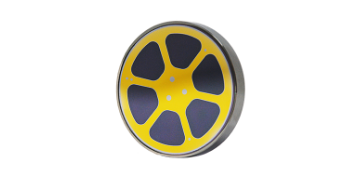Sputtered Coatings - Temperature & Humidity Stable

PRODUCT OVERVIEW
DSI’s photolithography capability enables production of patterned thin film coatings (including bandpass filters, absorption coatings, and metals) on substrates up to 6 inches in diameter.
DSI’s processes enable high placement accuracy, the ability to accurately maintain coating spectral properties at the smallest geometries, and two-sided patterning capabilities (for flat windows or filters). DSI utilizes both wet and dry film resist processes to support development and production of challenging patterned coating geometries for our customers.
THE DSI DIFFERENCE
DSI has over 30 years of experience in the design and manufacture of patterned filters for use at wavelengths ranging from the UV/visible through the near infrared, and recently developed capability through the long-wave infrared. Our experienced team work closely with our customers’ development and production teams to ensure successful integration of these highly specialized optics
DSI PATTERNED FILTER ADVANTAGES
- Up to 6 inches in diameter
- High placement accuracy
- Two-sided patterning capabilities
- Spectral properties maintained at the smallest geometries
DSI PATTERNED FILTER APPLICATIONS
- Intelligence, Surveillance, and Reconnaissance (ISR)
- Multi-spectral sensing and imaging
- Remote sensing
- Aerospace Intelligence
- Space Imaging
Contact Us For More Information
TECHNICAL INFORMATION
When developing a patterned filter, several variables must be considered, including:
- Spectral requirements for the coating(s) being deposited
- Feature sizes
- Alignment requirements of the features
- Substrate geometry
- Substrate material
- Number of different filters/coatings being deposited and patterned
Spectral requirements of the filter(s) can affect the size and positional accuracy of the features. More challenging optical filters require more layers to achieve required spectral performance. These layers result in coatings with significant physical thickness and can result in high film stress. As a result, thicker coatings are more challenging to pattern.
WAVELENGTH ACCURACY VS. COST
Tight tolerances (below ±0.5%) on center wavelength or edge placement can lower yield and thus adversely impact price. While extremely tight tolerances for these values can be achieved by measuring and selecting filters after fabrication, this can become expensive as part size increases, and may not be entirely practical in higher volumes.
ANGLE AND TEMPERATURE SENSITIVITY
The spectral characteristics of all optical coatings shift to shorter wavelengths as angle of incidence is increased, and/or temperature is decreased, and this can dramatically affect the performance of notch filters. In some cases, this effect can be purposefully employed to enable tuning of the filter’s performance over a limited range of wavelengths
General characteristics of DSI’s patterned filters are summarized in the table below.
| Parameter | Typical Specifications |
|---|---|
| Minimum Line Width | 50 μm |
| Dimensional Accuracy | ± 5 μm |
| Feature Placement | ± 5 μm |
| Front to Back Alignment | ± 10 μm |
| Largest Substrate Size | 200 mm Diameter, 127mm Square |
| Substrate Thickness | 0.0762mm to 8mm |
| Common Substrates | Fused Silica, BK7 & Other Glasses, Germanium, Indium Phosphide, Sapphire, Silicon |
| Maximum Coating Thickness | 20 μm |
| Resist Types | Wet and Dry Film Processing |

